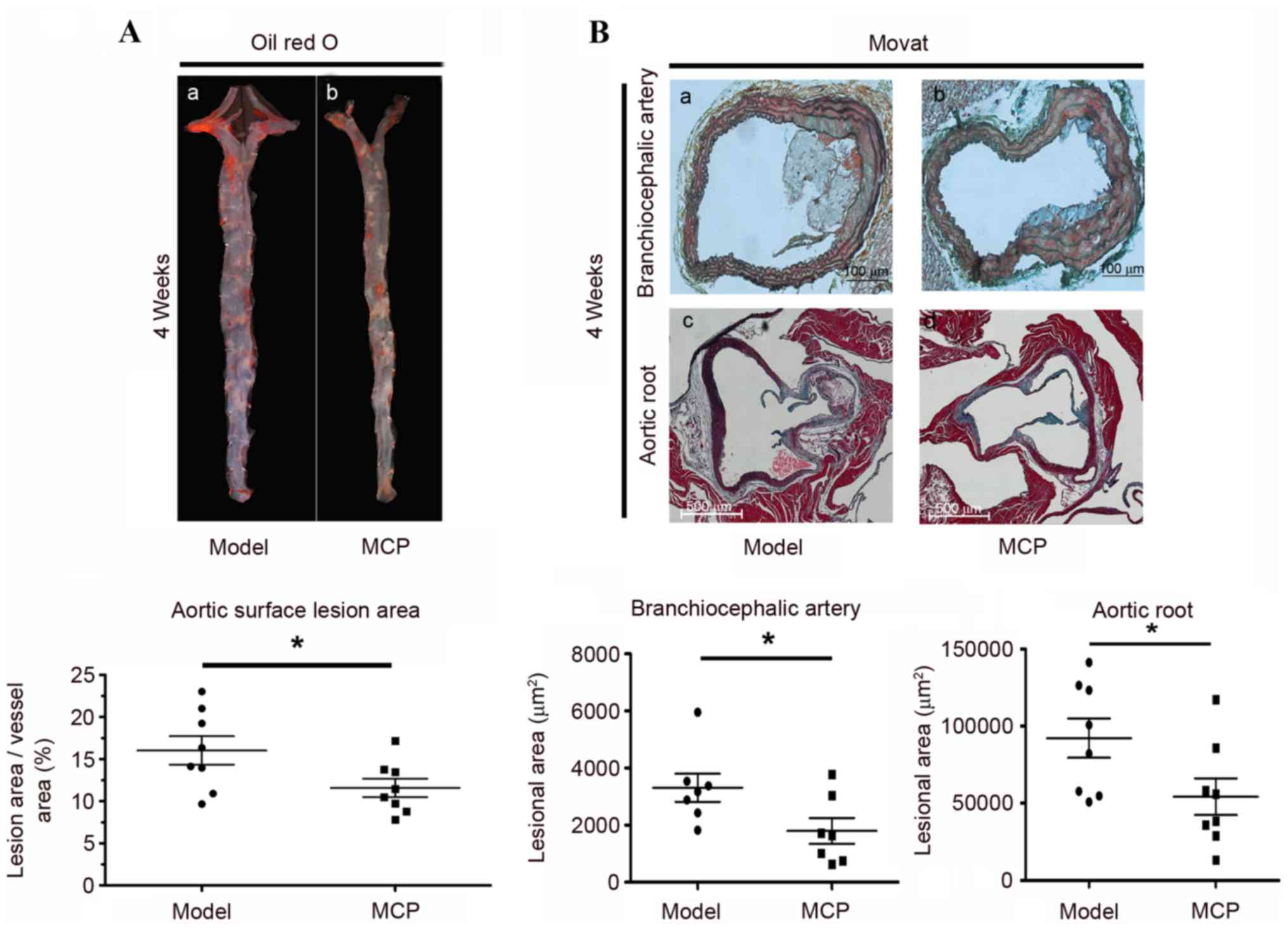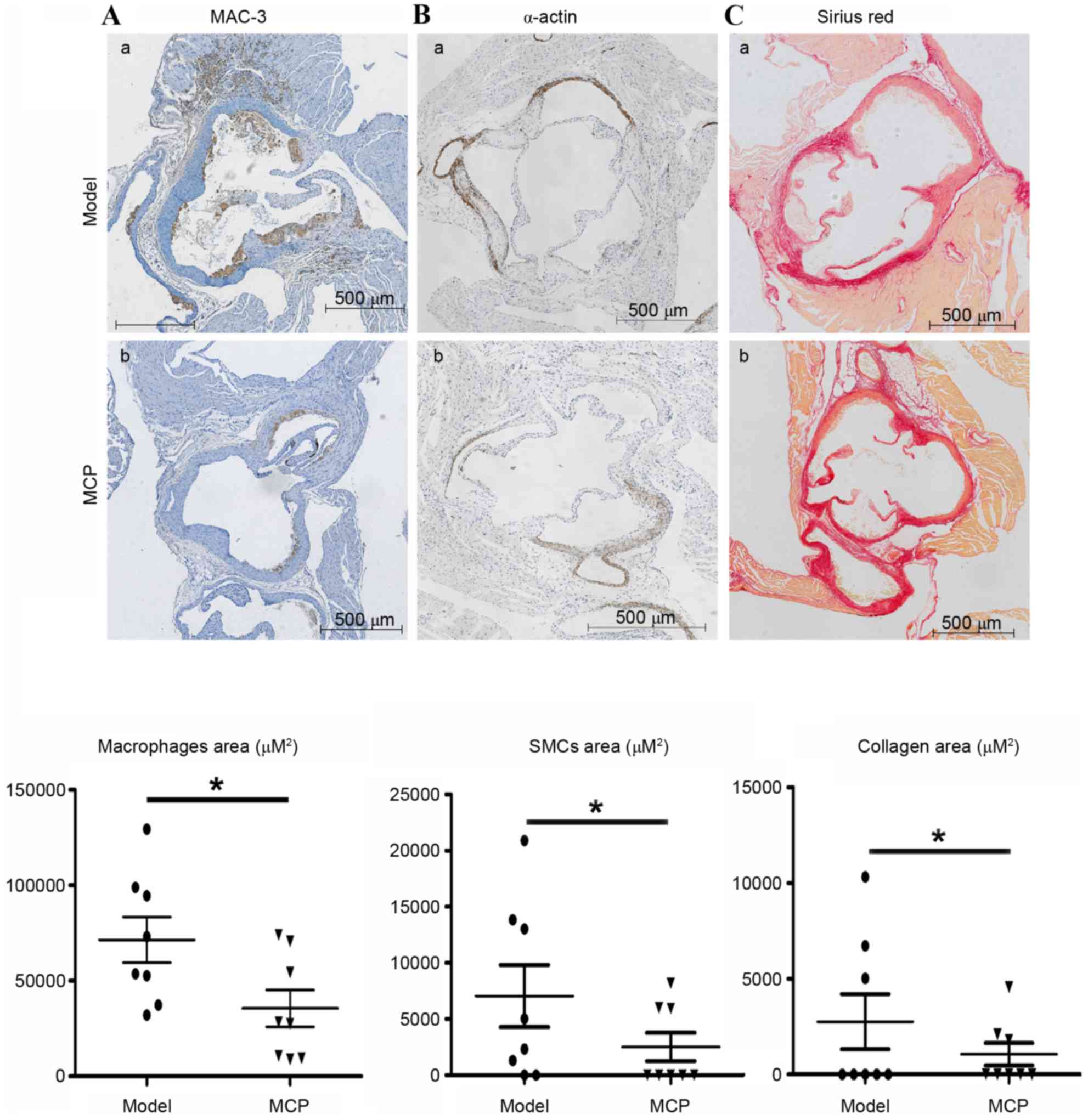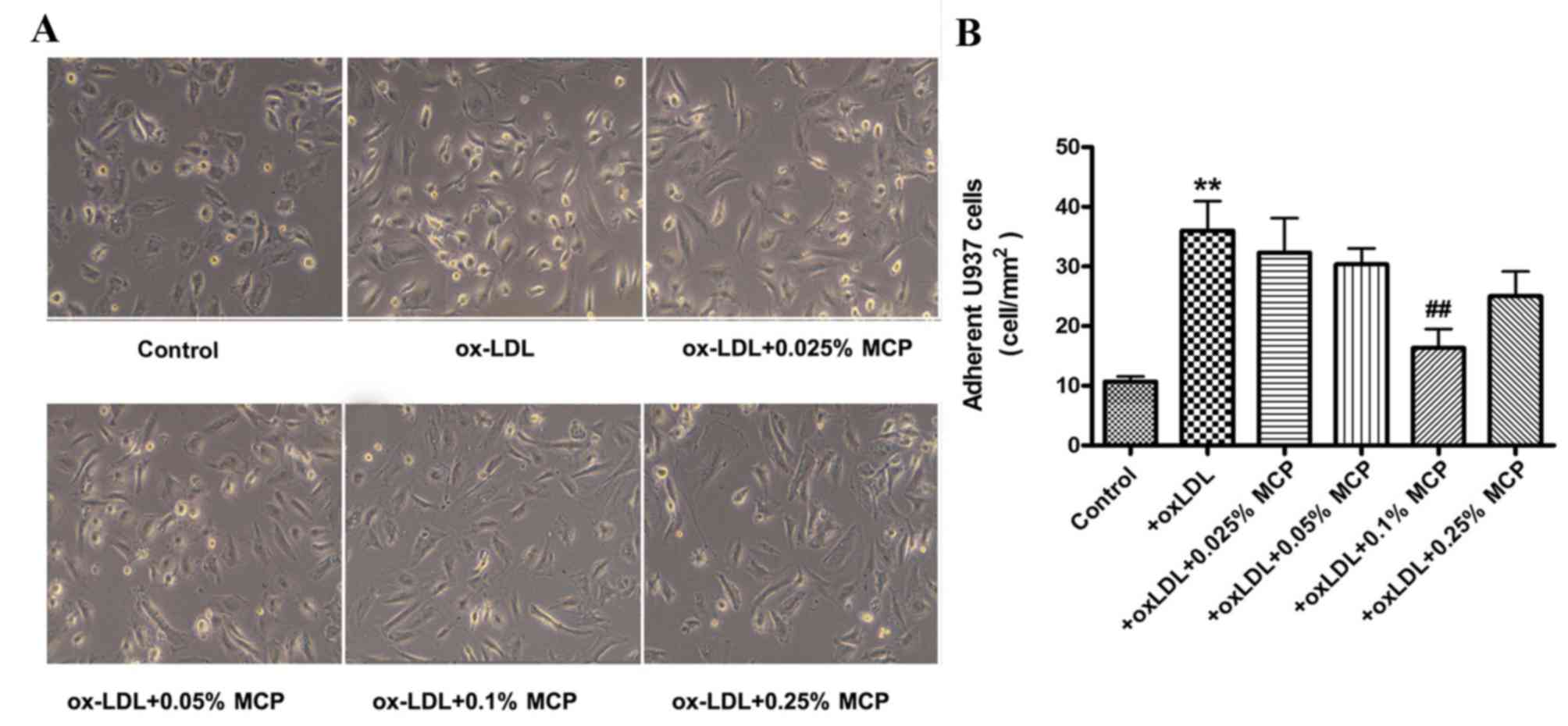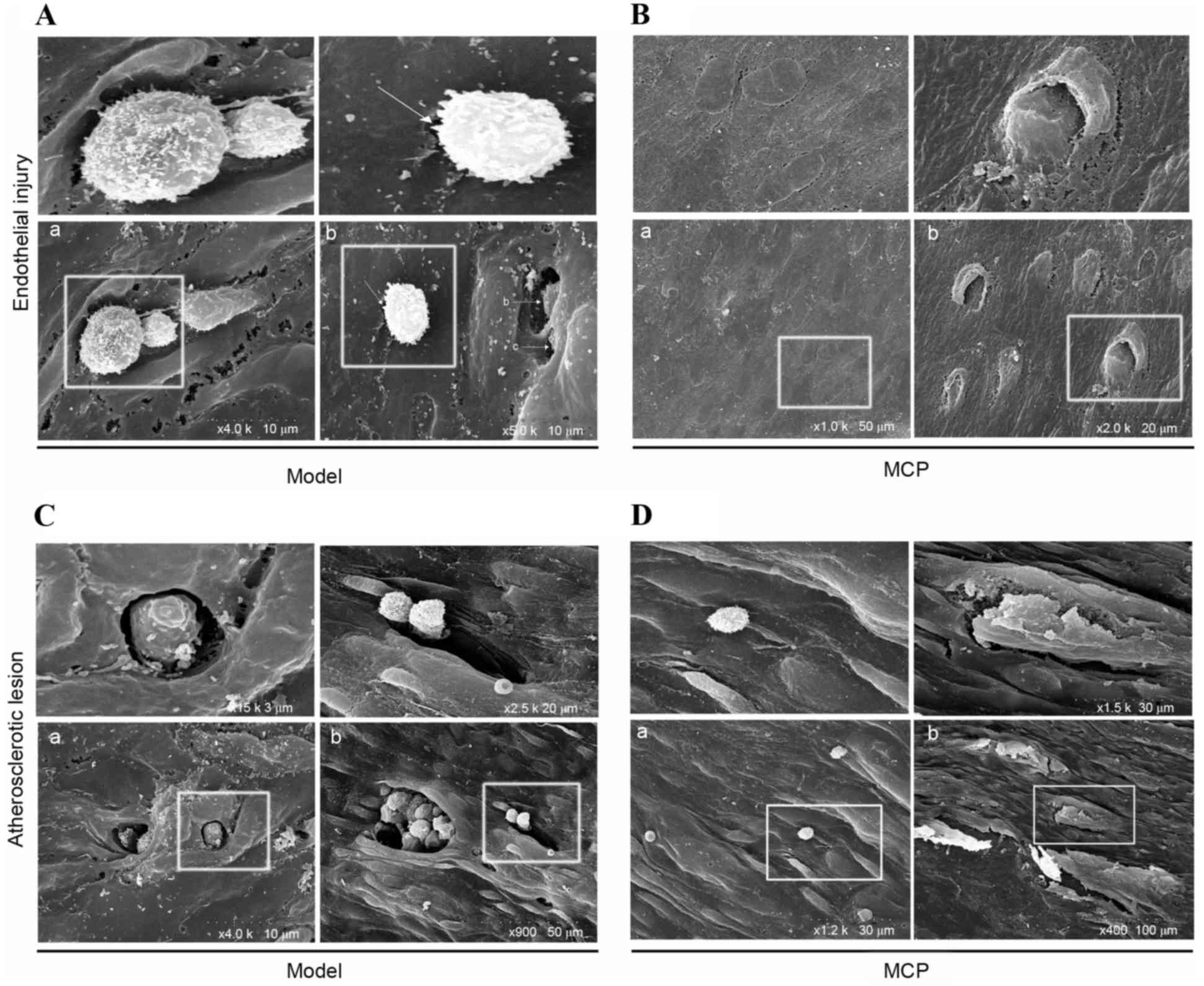Modified citrus pectin inhibits galectin-3 function to reduce atherosclerotic lesions in apoE-deficient mice
- Authors:
- Published online on: May 29, 2017 https://doi.org/10.3892/mmr.2017.6646
- Pages: 647-653
-
Copyright: © Lu et al. This is an open access article distributed under the terms of Creative Commons Attribution License.
Abstract
Introduction
Atherosclerosis is the predominant pathological cause of coronary artery disease, stroke and peripheral vascular disease. Endothelial dysfunction is considered to be the primary step of atherosclerosis, and various stimuli may induce this (1). Synthesis of adhesion molecules and chemokines by dysfunctional endothelial cells results in their cellular junctions becoming leakier; these steps induce early atherosclerotic lesions by mediating transient/rolling-type and firm adhesions of leucocytes and macrophages, as well as facilitating monocyte infiltration into the injured atheroma area (2). Leucocyte adhesion to vascular endothelial cells is a critical step in transendothelial migration. The infiltration of monocytes and other immune cells such as neutrophils, is mainly governed by interactions between chemokines or adhesion molecules and their associated receptors, such as vascular cell adhesion molecule-1 (VCAM-1) to α4β1 integrin, intercellular adhesion molecule-1 (ICAM-1) to αLβ2-integrin, and galectin-3 interaction with integrin β1, β3 and VCAM-1, either directly or indirectly (3).
Galectin-3 has numerous cellular locations, including the nucleus, the cell surface, and the extracellular environment. The location of galectin-3 depends on its ability to recognize extracellular matrix (ECM) components; particularly laminin, elastin and fibronectin, and these interactions facilitate cell-ECM attachment and transendothelial migration. Furthermore, this lectin may bridge neutrophilic and monocytic connections with the endothelium, either directly or indirectly (4). The release of reactive species and proteolytic enzymes, stimulated by the adhesion of neutrophils and monocytes, may subsequently induce endothelial erosion, aggravate endothelial cell dysfunction, and result in amplified vascular permeability and leucocyte accumulation in the atherosclerotic area. The predominant adhesion molecules expressed on the surface of neutrophils are β2-integrins; these serve a critical role in the recruitment and transmigration of neutrophils and monocytes (5–7). This is followed by endothelial cell surface-galectin-3 binding, which strengthens the adhesion (4). Galectin-3 has also been considered to promote cell-cell adhesion through a cross-linking of the Mac-2 binding protein, which is a member of the macrophage scavenger receptor cysteine-rich domain superfamily (8,9).
Galactin-3 may also have a similar effect to monocyte chemoattractant protein-1 (10), whereby extracellular galectin-3 may initiate alternative macrophage activation via interaction with cluster of differentiation (CD) 98 on macrophages. Furthermore, galectin-3 may serve as an advanced glycosylation end product clearance receptor, and a mediator of macrophage-led endocytosis of modified low-density lipoprotein (LDL), thus facilitating foam cell formation and subsequent amplification of inflammation (11,12). Cell surface and extracellular galectin-3 may therefore accelerate or decelerate atherosclerotic initiation and progression, by inducing the accumulation and activation of leucocytes.
Modified citrus pectin (MCP) is a complex polysaccharide obtained from the peel and pulp of citrus fruits. MCP powder is produced from citrus pectin using pH- and temperature-based processes to break it into shorter, non-branched, galactose-rich carbohydrate chains. This shorter polysaccharide enables MCP to access and bind tightly to galectin-3 by adhering to the carbohydrate recognition domain, thereby modulating the bioactivity of galectin-3 (13). Previous research indicated that either galectin-3 knockout or oral administration with MCP may reduce the atherosclerotic area in apolipoprotein E (apoE)-deficient mice; however, the exact mechanism remains unclear (14–16). The present study explored the effects of MCP on the initiation of atherosclerosis, and it was demonstrated that MCP may reduce the size of the atherosclerotic lesion by inhibiting leucocyte adhesion to endothelial cells.
Materials and methods
Preparation of animals
Male apoE−/− mice (age, 8 weeks, 20±2 g) bred from a C57BL/6J background were obtained from Jackson Laboratory (Peking University Health Science Center, Beijing, China). Mice (n=16) were fed a high-fat, cholesterol-rich atherogenic diet containing 21% fat, 19.5% casein and 1.25% cholesterol for 4 weeks and during the course of the experiment, all mice were allowed ad libitum access to food and water. They were maintained at 20–24°C with 45–55% humidity with a 12-h light-dark cycle. The mice were divided into two groups: MCP (n=8) and model (n=8) groups. A total of 1% MCP (Centrax International Corporation, San Francisco, USA) was added into the drinking water of the mice in the MCP group, for 4 weeks. All animal protocols were approved by the Animal Ethics Committee of the Beijing Institute of Geriatrics (Beijing, China).
Quantification of atherosclerotic lesions in the aortic root
Mice were sacrificed and hearts were sectioned throughout the aortic root; serial paraffinic sections of the heart were taken every 10 µm, according to the identified methods (12). Aortic roots were dissected and fixed overnight in 4% polymerized formaldehyde, paraffin embedded, and subsequently sectioned into 5 µm slices. Every sixth section was stained with a modified Movat pentachrome stain (SS0236; Xinhua Luyuan Science and Technology Ltd, Beijing, China), Sirius Red (DC0041; Leagene Biotechnology Co., Ltd., Beijing, China), to evaluate plaque areas and collagen. Briefly, the sections were stained with alcian blue, Verheoff's hematoxylin solution and then differentiated in 2% aqueous ferric chloride and subsequently stained in crocein scarlet-acid fuchsin and again differentiated in 5% aqueous phosphotungstic acid to achieve movat staining. The slides were stained with saturated picric acid Sirius red and alcoholic hematoxylin progressively, to observe lesional collagen content. All the stained slides were checked and captured microscopically by an upright microscope (Carl Zeiss AG, Oberkochen, Germany). Atherosclerotic lesions were analyzed using Image-Pro® Plus-6 software (Media Cybernetics, Inc., Rockville, MD, USA).
Immunohistochemistry
Regular sections from the excised aortic root were used for immunohistochemistry, to identify macrophages and smooth muscle cells (SMCs), according to a previously reported method (12). Briefly, sections were incubated with polyclonal antibodies at 37°C for 90 min or at 4°C overnight, and then labeled with horseradish peroxidase- or tetramethylrhodamine-conjugated anti-rabbit immunoglobulin G (catalog no. PV9000; OriGene Technologies, Inc., Beijing, China) at 37°C for 60 min. The coverslips were subsequently mounted with DABCO™ mounting medium, and analyzed using an upright microscope (Carl Zeiss AG, Oberkochen, Germany). Anti-α-actin (catalog no. sc-130616; 1:100) and anti-MAC-3, a highly glycosylated protein and a constituent of the lysosomal membrane that may be used as a macrophage marker, (or LAMP-2, catalog no. sc-81729; 1:100) antibodies were purchased from Santa Cruz Biotechnology, Inc. Dallas, TX, USA.
En face analysis of the descending aorta
The descending aortas were used for en face lipid staining. The aortas were dissected from the left subclavian artery to the iliac bifurcation, then opened longitudinally and stained with Oil Red O to visualize the extent of the lipid deposition. Aortic images were captured with a Sony DXC-960MD (Sony Corporation, Tokyo, Japan), and the lesion size was quantitatively analyzed. Data were analyzed with Image-Pro® Plus-6 software (Media Cybernetics, Inc.).
Cell culture and adhesion assays
CRL-1730 human umbilical vein vascular endothelial cells (HUVECs) were purchased from the American Type Culture Collection (Manassas, VA, USA) and were cultured in endothelial cell basal medium-2 Bullet kit media (Clonetics™; Lonza, Basel, Switzerland). Cells were grown to confluence at 37°C in 5% CO2, on 0.2% gelatin-coated culture dishes. Human monocytoid U937 cells (American Type Culture Collection) were cultured in RPMI-1640 medium supplemented with 10% fetal bovine serum (catalog no. 12633-012 and 10082139; Gibco; Thermo Fisher Scientific Inc., Waltham, MA, USA). To assess monocyte adhesion, HUVECs were plated onto 6-well gelatin-coated dishes at a density of 1.2×105 cells/well. The following day, cells were pretreated with oxidized-LDL (ox-LDL, catalog no. YB-002; Yiyuan Biotechnology, Guangzhou, China), after which MCP was added at various concentrations (0.025, 0.05, 0.1 and 0.25%, for 24 h). U937 cells (3×105 cells/well) were subsequently plated onto each monolayer, and incubated for 10 min under rotating conditions (63 rpm), at room temperature. Non-adherent cells were removed by gentle washing with MCDB 131 medium (Invitrogen; Thermo Fisher Scientific, Inc., Waltham, MA, USA), and monolayers were fixed with 1% paraformaldehyde and observed with an inverted microscope (CKX41; Olympus Corporation, Tokyo, Japan).
Scanning electron microscopy (SEM)
Branchiocephalic arteries (BCA) recovered from the mice were fixed with 2.5% gluteraldehyde in Millonig's phosphate buffer for 48 h, followed by post-fixation with 1% osmium tetroxide for 45 min. The specimens were dehydrated using increasing grades of ethyl alcohol (15 min in 50, 70, 80, and 95% alcohol, followed by three 10-min periods in 100% alcohol) and subsequently placed in an LPD-100 critical point dryer (S4800; Hitachi Limited, Inc., Tokyo, Japan) for 5 min at 41°C and 1,200 psi CO2. The tissues were then mounted on aluminum stubs with silver glue, sputter coated with gold, and examined using an SEM (17,18).
Statistical analysis
All values were presented as the mean ± standard error of the indicated number of measurements. An unpaired Student's t-test and analysis of variance were conducted, followed by post hoc testing with the Tukey procedure to determine significance. P<0.05 was considered to indicate a statistically significant difference.
Results
MCP treatment reduces the size of atherosclerotic lesions in apoE−/− mice
MCP is a naturally occurring inhibitor of galectin-3 carbohydrate binding (1,2). To investigate whether in vivo galectin-3 inhibition could reduce plaque size, apoE−/− mice were fed an atherogenic diet, with MCP (1%) supplemented in their drinking water, for 4 weeks. The size of the aortic lesion vs. the total arch area was determined, via quantitative histomorphological analysis of Oil Red O-stained en face specimens of the descending aorta. The area of lesioned aorta, compared with the total arch area, was reduced following MCP administration for 4 weeks (Fig. 1A). Similarly, the lesion size on the BCA and the aortic root was reduced in the MCP group, compared with the model group, as evidenced by Movat staining (Fig. 1B). These results indicated that MCP may reduce the size of the atherosclerotic lesion in apoE−/− mice.
MCP alters plaque structure and composition in apoE−/− mice
Atherosclerotic lesions are predominantly composed of macrophages, SMCs and collagen. Immunohistochemical probing for MAC-3, a marker of macrophages, indicated that MCP treatment resulted in fewer macrophages in the atherosclerotic lesions (Fig. 2A). Similarly, the amount of collagen and the number of SMCs were also reduced in the MCP-treated aortic root plaques (Fig. 2B and C).
MCP reduces in vitro adhesion of U937 monocytes to HUVECs
HUVECs were pretreated with ox-LDL and subsequently co-cultured with U937 cells. Treatment of HUVECs with ox-LDL increased the number of adherent monocytes (Fig. 3). However, subsequent incubation with various concentrations of MCP (0.025, 0.05, 0.1 and 0.25%) reduced the number of adherent U937 monocytes (Fig. 3).
MCP impairs endothelial injury in apoE−/− mice
SEM analysis was performed on the surface of the atheroma-prone vessel wall in apoE−/− mice. Pathological alterations caused by endothelial injury were observed in the model group; adherent monocytes were located at breakages in the endothelial cell junction (Fig. 4A-a). In the MCP group, endothelial junction sites were loose, however they did not appear to be broken (Fig. 4B-a). Notably, a monocyte was observed entering the endothelial barrier (Fig. 4B-b). From these results, it was speculated that the endothelial cell junctions recombined loosely, following monocyte transmigration, in the MCP-treated group. Furthermore, the lesion surface in the model group (Fig. 4C-a and -b) contained multiple disruption holes or ‘craters’, whereas the endothelium of the MCP group appeared to be of greater integrity (Fig. 4D-a and -b).
Discussion
The present study demonstrated that MCP-treated apoE−/− mice developed smaller atherosclerotic lesions, accompanied by fewer macrophages and SMCs and reduced amounts of collagen. Previous research (13) indicated that galectin-3-deficient mice had smaller atherosclerotic plaque volumes, and reduced intralesional macrophage accumulation and activation. Furthermore, the orally active inhibitor of galectin-3, MCP, may also reduce the atherosclerotic area; however, the precise mechanism remains unclear. The present study was therefore conducted to further investigate the role of galectin-3 in atherosclerosis. ApoE−/− mice fed an atherogenic diet (1.25% cholesterol) for 4 weeks displayed early or initial lesions (14); 1% MCP was therefore supplemented into the drinking water for 4 weeks, to evaluate the effects of MCP in early plaque formation. Oil Red O staining of en face specimens was performed to evaluate the total atherosclerotic area, and this revealed reduced aortic lesion areas in the MCP group, compared with the model group. Furthermore, the BCA and aortic root were examined pathologically, and lesional areas were observed to be significantly smaller in the MCP group compared with the model group.
Macrophages are the predominant cell type present in early atheroma plaques; they release various proinflammatory cytokines and chemokines, thereby inducing additional circulating monocytes to gather at the atheroma-prone areas, and to further differentiate into lesional macrophages, which is followed by vascular medial SMC migration and collagen synthesis (3). Analysis of the composition of the MCP-treated group lesions indicated fewer macrophages and SMCs, and reduced amounts of collagen, compared with the model group, thereby indicating that MCP may be able to protect against atherosclerotic development. Macrophages may interact with the ECM, at least partly, via galectin-3-induced differentiation and maturation (15). Galectin-3 is also chemotactic, guiding macrophages to lectin-rich locations in vivo and in vitro, and, similarly to monocyte chemoattractant protein-1, it may induce Ca2+ influx in monocytes; the chemotactic effect and the induction of Ca2+ influx may involve a PTX-sensitive pathway (10). Furthermore, galectin-3 is present on macrophages in atherosclerotic areas, and increased extracellular galectin-3 expression and secretion is a feature of alternative macrophage activation; galectin-3 interaction with CD98 results in the activation of phosphoinositide-3 kinase, and thus the alternative activation of macrophages. In addition, the interleukin-4-induced alternative activation pathway may be blocked via a specific inhibitor of extracellular galectin-3 carbohydrate binding (16). These results indicated that a galectin-3 feedback loop may induce alternative macrophage activation. Pharmacological modulation of galectin-3 function may therefore represent a novel therapeutic strategy in alternatively activated macrophage pathologies (19). The present study detected significantly reduced macrophage- and SMC-positive areas in atherosclerotic plaques in MCP-treated apoE−/− mice. Galectin-3 may promote the expression of monocytic chemokines, causing monocytes to preferentially migrate to, and accumulate in, vascular endothelial and arterial plaque lesions, particularly in lipid cores. This triggers the adhesion of macrophages to vascular endothelial cells, via interaction with laminin, fibronectin, elastin and collagen IV fibers (8). The transmigrated macrophages communicate with SMCs, leading to SMC activation and proliferation, in turn resulting in the appearance of SMCs in the atherosclerotic plaque. Since SMCs also synthesize collagen and other ECM components present in atherosclerotic lesions, a reduction in SMCs observed in the MCP group was concurrent with decreased amounts of collagen in the same group. Since lesional macrophages trigger and expand the accumulation of additional macrophages and medial SMCs to the lesion, the anti-atheroma effects of MCP may therefore mainly result from its inhibitory impact on macrophage adhesion.
The role served by the interaction between endothelial cells and monocytes/macrophages in atherosclerotic initiation is well documented (1). Monocyte and macrophage adhesion and sub-endothelial migration are the predominant processes associated with atherosclerotic initiation. Atheroma-prone areas are inflammatory sites; these may appeal to monocytes leaving the circulation, thus leading to endothelial cell anchorage via sequential attachments, which are mediated by several adhesion molecules, including galectin-3. It has previously been indicated that galectin-3 is expressed by various cell types including endothelial, epithelial and dendritic cells, and numerous inflammatory cells such as monocytes/macrophages, mast cells, neutrophils and eosinophils (20). Furthermore, galectin-3 is distributed on the cell surface, cytoplasm, and nucleus, as well as in the extracellular environment, indicating the multi-functionality of this lectin (21). Galectin-3 enables cell adhesion via cell-ECM-protein and cell-cell interactions. ECM proteins include laminin, fibronectin, proteoglycans, collagen and vitronectin, which are distributed in endothelial cells, the interstitial space and the basement membrane, and serve important roles in cell adherence (22). Galectin-3 participates in the ECM-cell adhesion process, and the association between galectin-3 and ECM proteins, particularly laminin and fibronectin, is essential for leucocyte movement. Furthermore, the interaction of galectin-3 with fibronectin is unique for the macrophage migratory process (23), indicating that galectin-3 may guide monocyte-derived macrophages to transmigrate across the endothelium and reach the arterial media, via its ECM binding ability. Previous studies have demonstrated that galectin-3 has no impact on the expression of adhesion molecules, such as selectin, ICAM, VCAM and very late antigen-4, indicating that galectin-3 is not an inflammatory modulator. Therefore, galectin-3 may predominantly guide macrophage movement via its binding affinity with the redistributed ligands in various vascular tissues. The associations between leucocytes and endothelial cells are primarily mediated by the interaction of various adhesion molecules, such as selectins and VCAM-1 to α4β1 integrin, and ICAM-1 to β2-integrin (24). VCAM-1 may mediate rolling-type adhesion and firm adhesion, depending on the avidity status of α4β1-integrin (25). It has been demonstrated that galectin-3 is capable of associating with β1 integrin, via its carbohydrate recognition domain, in a lactose-dependent manner (23). The binding of galectin-3 with α4β1 integrin may further modulate its receptor state and alter its affinity to VCAM-1; therefore, galectin-3 may be indirectly involved in α4β1-integrin-VCAM-1 dependent rolling and adhesion. To identify the impact of galectin-3 on endothelial cell-monocyte adhesion, the present study treated U937 monocytes with MCP, followed by co-incubation with ox-LDL stimulated HUVECs. The results revealed significantly greater numbers of adherent U937 monocytes on ox-LDL stimulated HUVECs, compared with controls. However, the number of adherent U937 cells was markedly reduced when they were pretreated with only 0.1% MCP.
The transendothelial migration of monocytes requires dynamic morphological alterations in endothelial cells. Monocyte adhesion induces endothelial F-actin contraction, thereby generating tension and facilitating the necessary changes to cellular morphology, which results in endothelial deformability (26). SEM analysis of transendothelial macrophages revealed large endothelial structure disruptions in the model group, whereas MCP-treated tissues had only a loosened endothelial structure. Furthermore, endothelial cell destruction was frequent in the atherosclerotic surfaces of the model group, whereas the atherosclerotic plaque surface remained intact in the MCP-treated group.
In conclusion, the present study demonstrated that MCP, a galectin-3 inhibitor, reduced atherosclerotic lesions via the inhibition of leucocyte adhesion to endothelial cells. Inhibiting galectin-3 function may be a promising therapeutic strategy for the treatment of atherosclerosis.
Acknowledgements
This study was supported by funding from the National Basic Research Program of China (grant no. 2012CB517502) and the National Natural Science Foundation of China (grant nos. 81270887 and 81070634).
References
|
Chistiakov DA, Revin VV, Sobenin IA, Orekhov AN and Bobryshev YV: Vascular endothelium: Functioning in norm, changes in atherosclerosis and current dietary approaches to improve endothelial function. Mini Rev Med Chem. 15:338–350. 2015. View Article : Google Scholar : PubMed/NCBI | |
|
Schäfer A and Bauersachs J: Endothelial dysfunction, impaired endogenous platelet inhibition and platelet activation in diabetes and atherosclerosis. Curr Vasc Pharmacol. 6:52–60. 2008. View Article : Google Scholar : PubMed/NCBI | |
|
Blankenberg S, Barbaux S and Tiret L: Adhesion molecules and atherosclerosis. Atherosclerosis. 170:191–203. 2003. View Article : Google Scholar : PubMed/NCBI | |
|
Rao SP, Wang Z, Zuberi RI, Sikora L, Bahaie NS, Zuraw BL, Liu FT and Sriramarao P: Galectin-3 functions as an adhesion molecule to support eosinophil rolling and adhesion under conditions of flow. J Immunol. 179:7800–7877. 2007. View Article : Google Scholar : PubMed/NCBI | |
|
Soehnlein O: Multiple roles for neutrophils in atherosclerosis. Circ Res. 110:875–888. 2012. View Article : Google Scholar : PubMed/NCBI | |
|
Nieminen J, St-Pierre C, Bhaumik P, Poirier F and Sato S: Role of galectin-3 in leukocyte recruitment in a murine model of lung infection by Streptococcus pneumoniae. J Immunol. 180:2466–2473. 2008. View Article : Google Scholar : PubMed/NCBI | |
|
Tadokoro T, Ikekita M, Toda T, Ito H, Sato T, Nakatani R, Hamaguchi Y and Furukawa K: Involvement of Galectin-3 with vascular cell adhesion molecule-1 in growth regulation of mouse BALB/3T3 cells. J Biol Chem. 284:35556–35563. 2009. View Article : Google Scholar : PubMed/NCBI | |
|
Inohara H, Akahani S, Koths K and Raz A: Interactions between galectin-3 and Mac-2-binding protein mediate cell-cell adhesion. Cancer Res. 56:4530–4534. 1996.PubMed/NCBI | |
|
Sasaki T, Brakebusch C, Engel J and Timpl R: Mac-2 binding protein is a cell-adhesive protein of the extracellular matrix which self-assembles into ring-like structures and binds beta1 integrins, collagens and fibronectin. EMBO J. 17:1606–1613. 1998. View Article : Google Scholar : PubMed/NCBI | |
|
Sano H, Hsu DK, Yu L, Apgar JR, Kuwabara I, Yamanaka T, Hirashima M and Liu FT: Human galectin-3 is a novel chemoattractant for monocytes and macrophages. J Immunol. 165:2156–2164. 2000. View Article : Google Scholar : PubMed/NCBI | |
|
Hopkins PN: Molecular biology of atherosclerosis. Physiol Rev. 93:1317–1542. 2013. View Article : Google Scholar : PubMed/NCBI | |
|
Tekabe Y, Li Q, Rosario R, Sedlar M, Majewski S, Hudson BI, Einstein AJ, Schmidt AM and Johnson LL: Development of receptor for advanced glycation end products-directed imaging of atherosclerotic plaque in a murine model of spontaneous atherosclerosis. Circ Cardiovasc Imaging. 1:212–219. 2008. View Article : Google Scholar : PubMed/NCBI | |
|
Gao X, Zhi Y, Zhang T, Xue H, Wang X, Foday AD, Tai G and Zhou Y: Analysis of the neutral polysaccharide fraction of MCP and its inhibitory activity on galectin-3. Glycoconj J. 29:159–165. 2012. View Article : Google Scholar : PubMed/NCBI | |
|
Nachtigal M, Ghaffar A and Mayer EP: Galectin-3 gene inactivation reduces atherosclerotic lesions and adventitial inflammation in ApoE-deficient mice. Am J Pathol. 172:247–255. 2008. View Article : Google Scholar : PubMed/NCBI | |
|
Jacob SS, Shastry P and Sudhakaran PR: Monocyte-macrophage differentiation in vitro: Modulation by extracellular matrix protein substratum. Mol Cell Biochem. 233:9–17. 2002. View Article : Google Scholar : PubMed/NCBI | |
|
MacKinnon AC, Farnworth SL, Hodkinson PS, Henderson NC, Atkinson KM, Leffler H, Nilsson UJ, Haslett C, Forbes SJ and Sethi T: Regulation of alternative macrophage activation by galectin-3. J Immunol. 180:2650–2658. 2008. View Article : Google Scholar : PubMed/NCBI | |
|
Walski M, Chlopicki S, Celary-Walska R and Frontczak-Baniewicz M: Ultrastructural alterations of endothelium covering advanced atherosclerotic plaque in human carotid artery visualized by scanning electron microscope. J Physiol Pharmacol. 53:713–723. 2002.PubMed/NCBI | |
|
Nathan L, Pervin S, Singh R, Rosenfeld M and Chaudhuri G: Estradiol inhibits leukocyte adhesion and transendothelial migration in rabbits in vivo: Possible mechanisms for gender differences in atherosclerosis. Circ Res. 85:377–385. 1999. View Article : Google Scholar : PubMed/NCBI | |
|
MacKinnon AC, Liu X, Hadoke PW, Miller MR, Newby DE and Sethi T: Inhibition of galectin-3 reduces atherosclerosis in apolipoprotein E-deficient mice. Glycobiology. 23:654–663. 2013. View Article : Google Scholar : PubMed/NCBI | |
|
Swarte VV, Mebius RE, Joziasse DH, Van den Eijnden DH and Kraal G: Lymphocyte triggering via L-selectin leads to enhanced galectin-3-mediated binding to dendritic cells. Eur J Immunol. 28:2864–2871. 1998. View Article : Google Scholar : PubMed/NCBI | |
|
Funasaka T, Raz A and Nangia-Makker P: Galectin-3 in angiogenesis and metastasis. Glycobiology. 24:886–891. 2014. View Article : Google Scholar : PubMed/NCBI | |
|
Hynes RO: The extracellular matrix: Not just pretty fibrils. Science. 326:1216–1219. 2009. View Article : Google Scholar : PubMed/NCBI | |
|
Hashiba K, Sano M, Nio-Kobayashi J, Hojo T, Skarzynski DJ and Okuda K: Galectin-3 contributes to luteolysis by binding to Beta 1 integrin in the bovine corpus luteum. Biol Reprod. 91:22014. View Article : Google Scholar : PubMed/NCBI | |
|
Hatley ME, Srinivasan S, Reilly KB, Bolick DT and Hedrick CC: Increased production of 12/15 lipoxygenase eicosanoids accelerates monocyte/endothelial interactions in diabetic db/db mice. J Biol Chem. 278:25369–25375. 2003. View Article : Google Scholar : PubMed/NCBI | |
|
Cybulsky MI, Iiyama K, Li H, Zhu S, Chen M, Iiyama M, Davis V, Gutierrez-Ramos JC, Connelly PW and Milstone DS: A major role for VCAM-1, but not ICAM-1, in early atherosclerosis. J Clin Invest. 107:1255–1262. 2001. View Article : Google Scholar : PubMed/NCBI | |
|
Ingber DE: Cellular tensegrity: Defining new rules of biological design that govern the cytoskeleton. J Cell Sci. 104:613–627. 1993.PubMed/NCBI |













